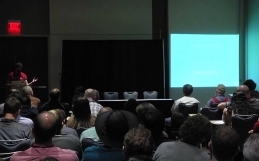Quantum Computing may not be mainstream to the Melbourne market any time soon but in the context of machine learning we thought we would find out a little more about what Canadian company D-Wave are up to. What they are doing is the computing equivalent of Unified Theory. Just to get the mind blowing bit out of the way, they are backed by Jeff Bezos, NASA and the CIA, each ‘hard drive’ costs around $15m and operates at 459 degrees below zero and even D-Wave find it extremely difficult to explain how their product works. To put the power of the machine into context, the guys at Google Quantum Artificial Intelligence Labs reckon it problem solves at least 35,500 times faster than IBMs CPLEX Optimiser, an optimization software package which was built to solve very large linear programming problems.
Quantum Computers rip up the rule book of conventional computers, where data is stored as binary and instead inherits quantum mechanics and uses ‘qubits’ which can be both 1s and 0s at the same time. A phenomenon know as Quantum Entanglement, which means that the quantum state of a bit cannot be described independently but runs the system as a whole, enables the system to perform multiple calculations simultaneously although there is still great difficulty in getting qubits to remain in their quantum state and not collapsing into binary.
The application of Quantum Computers to machine learning raises the possibility of faster research in areas such as the progress in cures for cancer or finding distant planets, helping understand cosmology, predicting weather patterns as well as advanced political and war simulation which could help governments make optimal decisions in order to avoid least favourable outcomes.
D-Wave’s product addresses shifting around large amounts of data which conventional computers have to do. The distance that stored data needs to travel results in processing delays whilst disks return data depending on bandwidth, especially across a distributed network and especially with large amounts of data and complexity such as machine learning. This makes it more efficient to minimise the amount of data moved between slow and fast memory. Machine learning may usually use multiple processors which each handle part of a problem but when a single machine is unable to handle that problem, consensus optimisation works better where the problem is broken up and distributed across a network of agents which must each reach a critical condition in order to return the data – if you can control the distributed cooperative systems where several autonomous agents collectively try to achieve a global objective.
Quantum computing aims to solve the problems of shifting data across distributed systems by harnessing this quantum entanglement and allowing the computer to make several decisions simultaneously and reach an optimised solution.
This video gives a high level picture of what D-Wave are up to –

